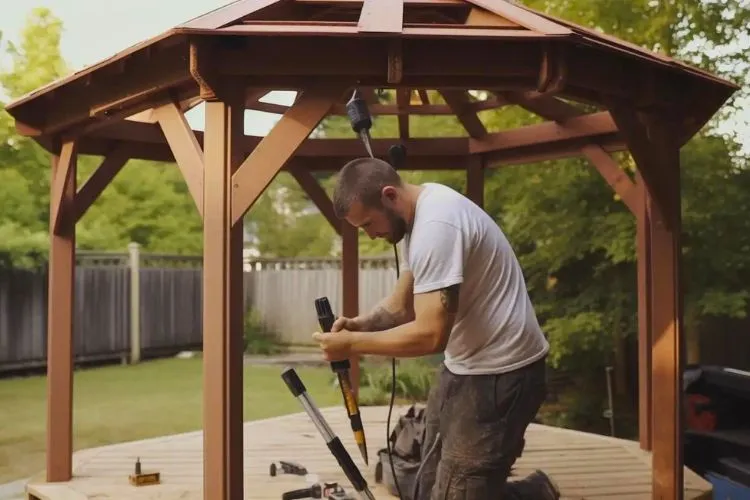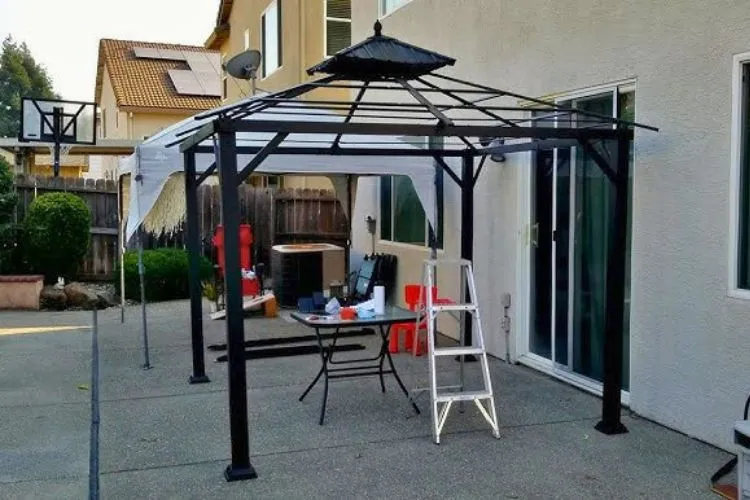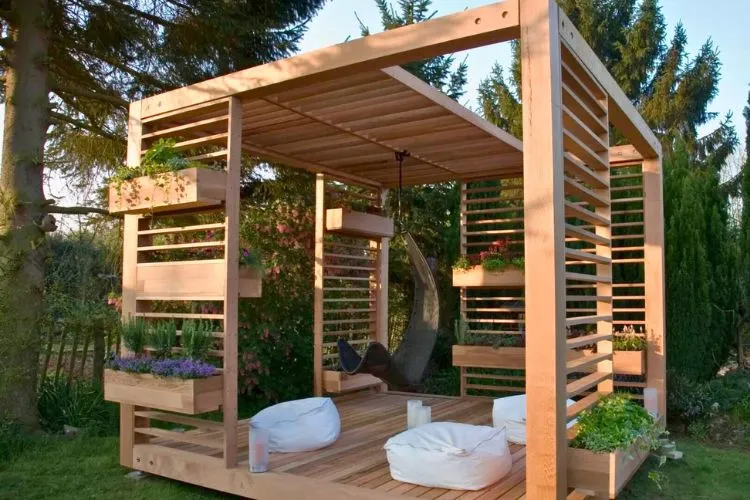Anchoring a gazebo securely is vital for its longevity and the safety of those who enjoy it.
Often, the process of installing a gazebo involves drilling into the ground or a deck to ensure it stays put, even in harsh weather conditions.
However, not everyone has the option or desire to drill holes. Reasons vary from lease restrictions, the wish to maintain the integrity of outdoor surfaces, or dealing with hard materials that are difficult to drill into.
Thankfully, there are effective methods to anchor gazebos without having to drill.
This article explores alternative solutions, providing a guide on how to anchor gazebo without drilling to keep it stable and secure.

Contents
- 1 Understanding the Need for Anchoring
- 2 How to Anchor Gazebo Without Drilling?
- 3 Installation Tips
- 4 Pro Tips
- 5 Customization and Decoration
- 6 Evaluating Your Gazebo’s Vulnerability
- 7 Legal and Safety Considerations
- 8 Frequently Asked Questions (FAQs)
- 8.1 Can I anchor a gazebo on a deck without drilling?
- 8.2 How much weight is needed to secure a gazebo?
- 8.3 What are the best weather conditions for setting up a non-drilled gazebo anchor?
- 8.4 How often should I check and maintain my gazebo anchors?
- 8.5 Can I move my gazebo once it’s anchored without drilling?
Understanding the Need for Anchoring
An unanchored gazebo poses risks. Wind can lift or shift it, causing property damage or injury to people nearby.
An anchored gazebo, in contrast, stands firm against the elements, offering a safe and enjoyable outdoor space.
How to Anchor Gazebo Without Drilling?
There are several no-drill methods for securing a gazebo. Each has its own set of advantages and can be chosen based on the specific conditions of the gazebo’s location.
Weights and Anchor Bags
One of the simplest solutions is to use weights or sandbags designed for gazebo legs.
By placing them at each corner, you distribute weight evenly, enhancing stability. Fill the bags with sand, rocks, or water to achieve the necessary weight.
Natural Anchors
Utilizing existing structures, such as trees or buildings, offers an innovative way to secure a gazebo.
With heavy-duty straps or ropes, you can tie the gazebo to these sturdy points, leveraging their stability to keep your structure in place.
Temporary Anchor Kits
Commercially available anchor kits provide a hassle-free solution. These kits often include weights or ground stakes that exert tension, holding the gazebo down without the need for drilling.
For a more permanent solution, consider placing each gazebo leg on a paver stone or in a small concrete footer.
Though this method doesn’t involve drilling into the existing surface, it offers a solid base for the gazebo.
Installation Tips
When setting up your gazebo using non-drilling methods, begin by choosing a flat, even area. This ensures that the gazebo will sit level, which is essential for both aesthetic and safety reasons.

Assemble your gazebo according to the manufacturer’s instructions, then proceed with the chosen anchoring method.
For instance, if using anchor bags, fill them to the recommended weight and secure them around each gazebo leg. Ensure everything is tightly fastened and the gazebo frame exhibits no signs of movement.
Pro Tips
For long-term stability, periodically check your gazebo’s anchoring system. Adjustments may be necessary, especially after extreme weather events.
Even without drilling, it’s possible to achieve a secure setup that withstands time and elements. Regular maintenance is key.
Customization and Decoration
Incorporating the anchoring method into the design of your gazebo and outdoor space prevents it from looking out of place.

If using weights, consider covering them with decorative elements such as plants or fabric. This not only disguises the anchor but also enhances the overall look of the area.
Evaluating Your Gazebo’s Vulnerability
The stability of your gazebo hinges on several factors. A heavier material, such as wood or wrought iron, naturally endows more stability compared to lightweight aluminum.
Gazebo design impacts resistance to wind; closed or partially enclosed gazebos may catch more wind and demand sturdier anchoring solutions.

Open designs, while allowing wind to pass through more easily, also require secure anchoring to avert toppling.
Additionally, your local climate plays a crucial role. Regularly brisk winds or the potential for severe weather necessitate a robust anchoring strategy to ensure your gazebo remains a safe and enjoyable addition to your outdoor space.
Legal and Safety Considerations
Before installing a gazebo, it’s critical to investigate local regulations and guidelines. Municipalities might require permits for structures over a certain size, while rented properties may have specific restrictions outlined in lease agreements.

Similarly, homeowners’ associations often enforce rules regarding outdoor structures to maintain aesthetic uniformity and safety standards. Ignoring these can lead to legal issues or the need to dismantle your gazebo.
Safety is paramount during both installation and subsequent use. Ensure the gazebo is securely anchored to prevent it from becoming a hazard in strong winds.
Select materials and designs that are durable and appropriate for your region’s climate. When assembling the gazebo, follow manufacturer instructions closely to avoid structural weaknesses that could lead to collapses or injuries.
Regular inspections for wear and tear can prevent unexpected accidents, ensuring that your gazebo remains a secure and enjoyable retreat in your outdoor space.
Frequently Asked Questions (FAQs)
Can I anchor a gazebo on a deck without drilling?
Yes. Using weights or anchor bags is a popular method for securing gazebos on decks without drilling. Ensure the weights are heavy enough to prevent movement.
How much weight is needed to secure a gazebo?
The necessary weight varies depending on the gazebo’s size and the weather conditions in your area. Generally, at least 40 pounds per leg is a good starting point, but more may be required in windy locations.
What are the best weather conditions for setting up a non-drilled gazebo anchor?
Set up your gazebo on a calm, clear day. This allows you to properly secure the gazebo without battling wind or rain, ensuring a safe and stable installation.
How often should I check and maintain my gazebo anchors?
Inspect your gazebo’s anchoring system at the start of each season and after significant weather events. Adjust or reinforce as needed to maintain stability.
Can I move my gazebo once it’s anchored without drilling?
Yes, one of the benefits of non-drilling methods is the ability to relocate your gazebo. Simply remove the anchoring system, move the gazebo, and re-apply the anchoring method at the new site.
Conclusion:
Anchoring a gazebo securely doesn’t necessarily require drilling. By using weights, anchor kits, or leveraging natural anchors, you can ensure your gazebo remains a stable and safe feature in your outdoor space.
Each method has its own advantages and can be selected based on your specific needs and conditions.
With proper installation and regular maintenance, your gazebo will provide a secure, enjoyable outdoor haven for years to come, all without the need to drill a single hole.

Sergio Gomes, a passionate advocate for outdoor living and the male voice behind Shades Authority. With years of experience, Sergio is your trusted source for expert insights on gazebos, pavilions, cabanas, pergolas, and all things outdoor shade solutions. Join him on a journey to transform your outdoor spaces into stunning, functional retreats
